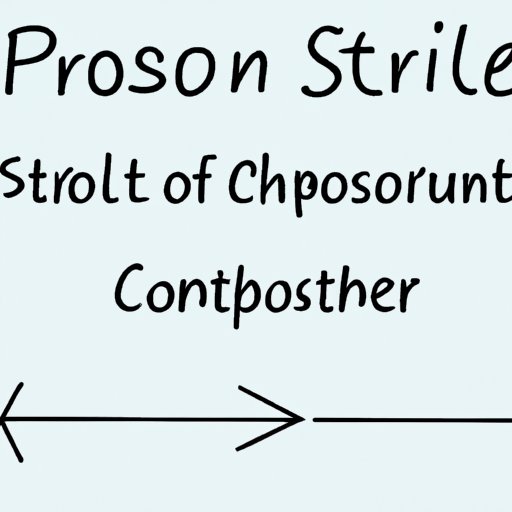Introduction
Plot is the backbone of any story. It’s what drives the narrative forward and keeps readers engaged. But what exactly is plot in writing? Put simply, plot is the sequence of events that make up a story. It includes all of the conflicts, twists, and turns that shape the narrative arc and keep readers on the edge of their seats. In this article, we’ll explore the role of plot in writing, from the basics of plot structure to tips and techniques for mastering the art of plotting.
Exploring the Role of Plot in Writing
To understand plot in writing, it’s helpful to first consider what plot is in fiction. Generally speaking, plot is the sequence of events that occur in a story. It includes all of the conflicts, twists, and turns that shape the narrative arc and keep readers invested. The plot is often divided into three main sections: the beginning, the middle, and the end. This structure is often referred to as the three-act structure.
The role of conflict in plot cannot be overstated. Conflict is the driving force behind any story. It’s what creates tension and keeps readers turning the pages. Without conflict, there’s no plot. There are many types of conflict, including internal (a character’s inner struggle) and external (a character’s struggle against another character or an outside force).

Unpacking the Elements of a Story: An Overview of Plot
Plot isn’t just about conflict; it’s also about character development and motivation. Characters are the driving force behind any story, and they must be fleshed out in order to create a compelling narrative. Character development helps create empathy and connection with readers. Motivation is also key; characters must have a clear goal or purpose in order to drive the plot forward.
Setting, tone, and theme are also important elements of plot. Setting is the environment in which the story takes place. Tone is the overall feeling or mood of the story. And theme is the underlying message or moral of the story. All of these elements help to create a more engaging and immersive experience for readers.
Dialogue and subplots are two additional elements that can add complexity and depth to a story. Dialogue helps to move the plot forward by revealing information and advancing the narrative. Subplots are smaller stories within the main story that provide additional context and insight into the characters and their motivations.
A Beginner’s Guide to Understanding Plot Structure
Now that we’ve explored the elements of a story, let’s take a look at plot structure. Plot structure is the way in which the story is told. It includes the order in which events occur, as well as the pacing and flow of the narrative. There are five main parts to plot structure: the hook, rising action, climax, falling action, and resolution.
The hook is the introduction to the story. It’s the part of the story that draws readers in and makes them want to keep reading. Rising action is the buildup of tension and suspense leading up to the climax. The climax is the most dramatic point of the story, when the main conflict is resolved. Falling action is the events that follow the climax and tie up loose ends. Finally, the resolution is the conclusion of the story, when all questions are answered and the story comes to a satisfying close.

How to Write Engaging Plots for Your Writing Projects
Writing engaging plots for your writing projects requires some creativity and planning. Before you start writing, it’s important to brainstorm ideas and flesh out characters. Think about who your characters are and what motivates them. Consider the setting and how it can be used to add depth and complexity to the story.
Crafting a Compelling Narrative Through Plot Development
Once you have the basic elements of your plot in place, you can begin to develop the narrative. Introducing conflict and building suspense will help engage readers and keep them hooked. Creating interesting twists and turns will make your story unique and memorable. As you craft your narrative, remember to keep the focus on the characters and their motivations.

Creating Conflict and Resolution Through Plot
Conflict is essential to any good story. Without it, there’s no plot. When creating conflict, think about the different types of conflict and how they can be used to drive the plot forward. Internal conflicts are usually more interesting than external conflicts, as they offer more opportunities for character development. Once you’ve established the conflict, you need to create a resolution. Strategies for resolving conflict include compromise, reconciliation, and acceptance.
Mastering the Art of Plotting: Tips and Techniques
Mastering the art of plotting involves taking risks and pushing yourself to come up with new and creative ideas. Developing multiple storylines and taking risks with your plots can help create a more engaging and dynamic story. Additionally, it’s important to avoid common pitfalls such as relying too heavily on cliches or overusing stereotypes.
Conclusion
Plot is an essential element of any story. It provides the structure and foundation upon which a story is built. By understanding the role of plot in writing and exploring the elements of a story, you can craft compelling narratives and engage your readers. Crafting engaging plots requires creativity, risk-taking, and an understanding of conflict and resolution. With practice and dedication, anyone can become a master of plotting.
(Note: Is this article not meeting your expectations? Do you have knowledge or insights to share? Unlock new opportunities and expand your reach by joining our authors team. Click Registration to join us and share your expertise with our readers.)
